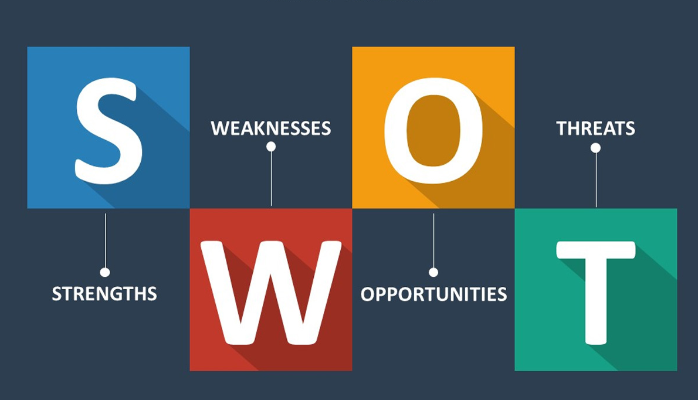Here's a detailed explanation of each component of a SWOT analysis:
1. Strengths:
Internal Positive Attributes: These are the internal, positive factors that give your business an advantage over others.
Examples: Strong brand reputation, unique products or services, well-experienced team, efficient internal processes, loyal customer base, proprietary technology or intellectual property, financial stability, and a well-established online presence.
1) Unique Selling Proposition (USP): What makes your business stand out? Identify your strengths, such as unique products, expertise, or innovative solutions.
2) Expertise and Skills: Assess your team's skills and experience, which can give you a competitive advantage.
3) Resources: Consider your available resources, including financial, human, and technological resources.
4) Reputation: If you have an existing positive reputation or network in the industry, it can be a significant strength.
5) Quality: If your product or service is of high quality, it can be a strength.
6) Location: A prime location can be an advantage, especially for retail or service-based businesses.
2. Weaknesses:
Internal Negative Attributes: These are the internal, negative aspects that your business needs to address or improve.
Examples: Lack of experience, limited resources (financial, human, or technological), inefficient processes, high employee turnover, poor customer service, outdated technology, and inconsistent branding.
1) Lack of Experience: If you or your team lack experience in the industry, this can be a weakness.
2) Limited Resources: A shortage of financial, human, or technical resources can hinder your business.
3) Dependencies: Identify any key dependencies on suppliers, employees, or other external factors.
4) Operational Inefficiencies: Any internal inefficiencies or bottlenecks can be a weakness.
5) Brand Recognition: If your brand is not well-known, it can be a challenge to attract customers.
3. Opportunities:
External Favorable Factors: These are external factors in the business environment that can be leveraged for growth and success.
Examples: Emerging markets, changing consumer trends, technological advancements, a growing demand for a product or service, favorable economic conditions, expanding global markets, and potential partnerships or collaborations.
1) Market Growth: Look for trends and indications of market growth in your industry.
2) Changing Customer Preferences: Identify any shifts in customer preferences or emerging trends that you can leverage.
3) Technological Advancements: Consider how new technologies can benefit your business.
4) Economic Conditions: Positive economic conditions can create opportunities for expansion.
5) Competitor Weaknesses: If your competitors have weaknesses, it can be an opportunity for your business to excel.
4. Threats:
External Unfavorable Factors: These are external factors outside of your control that could negatively impact your business.
Examples: Intense competition, economic recessions, changes in regulations, market saturation, supply chain disruptions, natural disasters, and negative publicity or public relations crises.
1) Competition: The presence of strong competitors in your industry can pose a threat.
2) Market Saturation: If the market is oversaturated with similar products or services, it can be challenging to gain a foothold.
3) Economic Downturn: Economic recessions or downturns can affect consumer spending and your business's stability.
4) Regulations and Compliance: Changing regulations or compliance requirements can be a threat.
5) Supplier Issues: Dependency on a single supplier or suppliers can create vulnerabilities.
How to Conduct a SWOT Analysis?
1) Gather a Cross-Functional Team: It's often helpful to involve a diverse team from different departments in your organization to gain multiple perspectives.
2) Brainstorm and List Factors: Begin by brainstorming factors that fall into each of the four categories: Strengths, Weaknesses, Opportunities, and Threats. Ensure that these factors are specific and relevant to your business or project.
3) Categorize and Prioritize: Organize the listed factors into the appropriate categories and prioritize them based on their significance and potential impact.
4) SWOT Matrix: Create a SWOT matrix with four quadrants, placing your prioritized factors in each quadrant.
5) Develop Strategies: Use the SWOT analysis to inform your business strategies. Here's how you can use it:
Strengths-Opportunities (SO): Capitalize on your strengths to exploit opportunities.
Strengths-Threats (ST): Use your strengths to mitigate potential threats.
Weaknesses-Opportunities (WO): Improve weaknesses to take advantage of opportunities.
Weaknesses-Threats (WT): Address weaknesses to defend against threats.
6) Action Plan: Develop specific action plans based on your strategies. Assign responsibilities and set deadlines.
7) Regular Review: Periodically revisit and update your SWOT analysis to adapt to changing circumstances, market dynamics, and your business's growth.
Steps to Perform a SWOT Analysis
1) Create a SWOT matrix with four quadrants: Strengths, Weaknesses, Opportunities, and Threats.
2) Brainstorm and list factors under each category, considering both internal and external factors.
3) Prioritize the most critical factors in each category.
4) Use your SWOT analysis to inform your business strategy. Leverage strengths, address weaknesses, seize opportunities, and mitigate threats.
5) Regularly revisit and update your SWOT analysis to adapt to changing circumstances.
A SWOT analysis can serve as a valuable tool in developing your business strategy and decision-making process. It allows you to identify potential challenges and opportunities, which is essential for a successful business launch and ongoing growth.
A well-executed SWOT analysis provides a comprehensive understanding of your business's internal and external environment, enabling you to make informed decisions, set clear objectives, and formulate strategies that leverage your strengths, mitigate weaknesses, capitalize on opportunities, and defend against threats.





Social Plugin